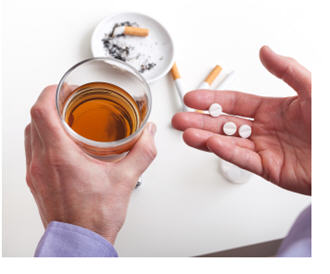
Alcohol, Tobacco, Drug Use Far Higher in Severely Mentally Ill
St. Louis, MO; January 1, 2014—In the largest ever assessment of substance use among people with severe psychiatric illness, researchers at Washington University School of Medicine in St. Louis and the University of Southern California have found that rates of smoking, drinking and drug use are significantly higher among those who have psychotic disorders than among those in the general population.
The study is published online in the journal JAMA Psychiatry.
The finding is of particular concern because individuals with severe mental illness are more likely to die younger than people without severe psychiatric disorders.
“These patients tend to pass away much younger, with estimates ranging from 12 to 25 years earlier than individuals in the general population,” said first author Sarah M. Hartz, MD, PhD, assistant professor of psychiatry at Washington University. “They don’t die from drug overdoses or commit suicide—the kinds of things you might suspect in severe psychiatric illness. They die from heart disease and cancer, problems caused by chronic alcohol and tobacco use.”
The study analyzed smoking, drinking and drug use in nearly 20,000 people. That included 9,142 psychiatric patients diagnosed with schizophrenia, bipolar disorder or schizoaffective disorder—an illness characterized by psychotic symptoms such as hallucinations and delusions, and mood disorders such as depression.
The investigators also assessed nicotine use, heavy drinking, heavy marijuana use and recreational drug use in more than 10,000 healthy people without mental illness.
The researchers found that 30 percent of those with severe psychiatric illness engaged in binge drinking, defined as drinking four servings of alcohol at one time. In comparison, the rate of binge drinking in the general population is 8 percent.
Among those with mental illness, more than 75 percent were regular smokers. This compares with 33 percent of those in the control group who smoked regularly. There were similar findings with heavy marijuana use: 50 percent of people with psychotic disorders used marijuana regularly, versus 18 percent in the general population. Half of those with mental illness also used other illicit drugs, while the rate of recreational drug use in the general population is 12 percent.
“I take care of a lot of patients with severe mental illness, many of whom are sick enough that they are on disability,” said Hartz. “And it’s always surprising when I encounter a patient who doesn’t smoke or hasn’t used drugs or had alcohol problems.”
Hartz said another striking finding from the study is that once a person develops a psychotic illness, protective factors such as race and gender don’t have their typical influence.
Previous research indicates that Hispanics and Asians tend to have lower rates of substance abuse than European Americans. The same is true for women, who tend to smoke, drink and use illicit drugs less often than men.
“We see protective effects in these subpopulations,” Hartz explained. “But once a person has a severe mental illness, that seems to trump everything.”
That’s particularly true, she said, with smoking. During the last few decades, smoking rates have declined in the general population. People over age 50 are much more likely than younger people to have been regular smokers at some point in their lives. For example, about 40 percent of those over 50 used to smoke regularly. Among those under 30, fewer than 20 percent have been regular smokers. But among the mentally ill, the smoking rate is more than 75 percent, regardless of the patient’s age.
“With public health efforts, we’ve effectively cut smoking rates in half in healthy people, but in the severely mentally ill, we haven’t made a dent at all,” she said.
Until recently, smoking was permitted in most psychiatric hospitals and mental wards. Hartz believes that many psychiatrists decided that their sickest patients had enough problems without having to worry about quitting smoking, too. There also were concerns about potential dangers from using nicotine-replacement therapy, while continuing to smoke since smoking is so prevalent among the mentally ill. Recent studies, however, have found those concerns were overblown.
The question, she said, is whether being more aggressive in trying to curb nicotine, alcohol and substance use in patients with severe psychiatric illness can lengthen their lives. Hartz believes health professionals who treat the mentally ill need to do a better job of trying to get them to stop smoking, drinking and using drugs.
“Some studies have shown that although we psychiatrists know that smoking, drinking and substance use are major problems among the mentally ill, we often don’t ask our patients about those things,” she said. “We can do better, but we also need to develop new strategies because many interventions to reduce smoking, drinking and drug use that have worked in other patient populations don’t seem to be very effective in these psychiatric patients.”
ARTICLE:
“Comorbidity of Severe Psychotic Disorders With Measures of Substance Use,” Sarah M. Hartz, MD, PhD; Carlos N. Pato, MD, PhD; Helena Medeiros, MSW; Patricia Cavazos-Rehg, PhD; Janet L. Sobell, PhD; James A. Knowles, MD, PhD; Laura J. Bierut, MD; Michele T. Pato, MD; for the Genomic Psychiatry Cohort Consortium. JAMA Psychiatry, January 1, 2014.
